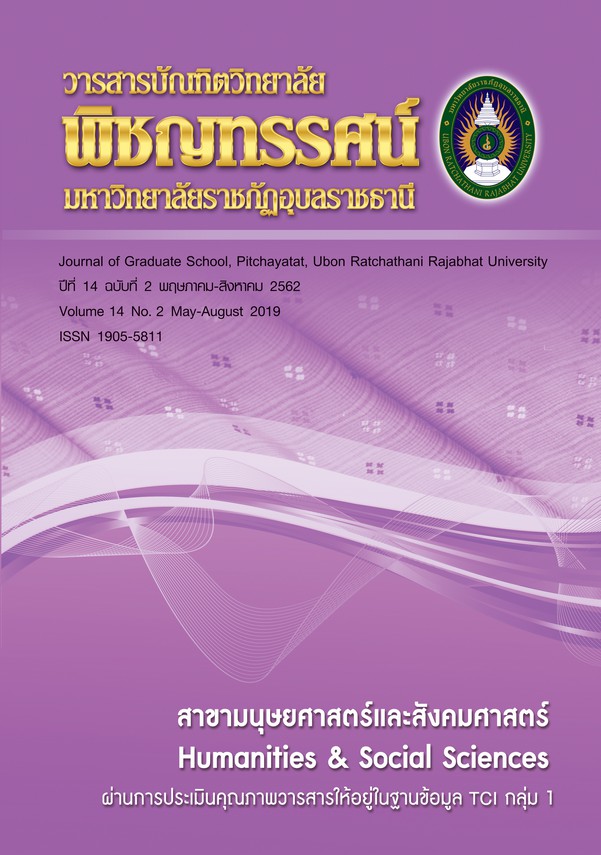รูปแบบการจัดการเรียนรู้แบบบูรณาการตามแนวสะเต็มศึกษาเพื่อพัฒนาความคิดสร้างสรรค์เชิงผลิตภัณฑ์สำหรับนักเรียนระดับชั้นมัธยมศึกษาตอนต้น
คำสำคัญ:
รูปแบบการจัดการเรียนรู้สะเต็มศึกษา, ความคิดสร้างสรรค์เชิงผลิตภัณฑ์, นักเรียนระดับชั้นมัธยมศึกษาตอนต้นบทคัดย่อ
การวิจัยนี้มีวัตถุประสงค์เพื่อพัฒนารูปแบบการจัดการเรียนรู้แบบบูรณาการตามแนวสะเต็มศึกษาเพื่อพัฒนาความคิดสร้างสรรค์เชิงผลิตภัณฑ์สำหรับนักเรียนระดับชั้นมัธยมศึกษาตอนต้น กลุ่มตัวอย่างได้แก่ 1) ทูตสะเต็มและครูที่ได้รับรางวัลสะเต็มศึกษาจำนวน 30 คน โดยการสุ่มแบบเจาะจง 2) ผู้เชี่ยวชาญจำนวน 7 คน เครื่องมือได้แก่ แบบสัมภาษณ์แบบมีโครงสร้าง แบบประเมิน สถิติที่ใช้ในการวิเคราะห์ข้อมูลประกอบด้วย การวิเคราะห์เชิงเนื้อหา ความถี่ และค่าความสอดคล้องระหว่างข้อคำถามกับวัตถุประสงค์ ผลการวิจัยพบว่า รูปแบบ ประกอบด้วย 5 กิจกรรม คือ 1) กระตุ้นการเรียนรู้ด้วยสถานการณ์ปัญหา 2) ระดมสมองร่วมกันวิเคราะห์สถานการณ์ปัญหา 3) สืบค้นข้อมูลและดำเนินการแก้ปัญหา ซึ่งแบ่งเป็น 6 ขั้น ได้แก่ 3.1) ขั้นระบุปัญหา 3.2) ขั้นรวบรวมข้อมูลและแนวคิดที่เกี่ยวข้อง 3.3) ขั้นออกแบบวิธีการแก้ปัญหา 3.4) ขั้นวางแผนและดำเนินการแก้ปัญหา 3.5) ขั้นทดสอบและปรับปรุง และ 3.6) ขั้นนำเสนอ 4) นำองค์ความรู้มาเชื่อมโยงและประยุกต์ใช้ และ 5) ประเมินผลตามสภาพจริง ผลการประเมินรูปแบบการจัดการเรียนรู้แบบบูรณาการตามแนวสะเต็มศึกษา พบว่ามีค่าความสอดคล้อง =0.96 และมีค่าดัชนีความเหมาะสมของรูปแบบการจัดการเรียนรู้แบบบูรณาการตามแนวสะเต็มศึกษา =0.93
เอกสารอ้างอิง
แน่งน้อย อินคะเน. การจัดการเรียนรู้โดยใช้รูปแบบการสอนวัฎจักร การสืบเสาะความรู้ 7 ขั้นร่วมกับเทคนิคผังกราฟิกที่มีต่อ ผลสัมฤทธิ์ทางการเรียนวิทยาศาสตร์ และความสามารถในการคิดวิเคราะห์ของนักเรียนชั้นประถมศึกษาปีที่ 6.วารสาร AL-NUR บัณฑิตวิทยาลัย มหาวิทยาลัยฟาฏอนี. 10, 19 กรกฎาคม – ธันวาคม 2558): 85-96.
บุญณิตา จิตรึเชาว์. การพัฒนาความคิดสร้างสรรค์โดยใช้แบบฝึกทักษะความคิดสร้างสรรค์ในวิชาโครงงานคอมพิวเตอร์. Teachnical education Journal King Mongkut’s University of Technology North Bangkok. 8, 1 (January-June 2560): 70-76
ปราณปรียา พรมสิทธิ์. การเปรียบเทียบผลสัมฤทธิ์ทางการเรียนสังคมศึกษา เจตคติต่อการใส่ใจสิ่งแวดล้อมและจิตสาธารณะของนักเรียนชั้นมัธยมศึกษาปีที่ 3 โดยการจัดการเรียนรู้แบบบูรณาการกับแบบปกติ. วารสารบัณฑิตวิทยาลัยพิชญทรรศน์. 12, 1 (มกราคม-มิถุนายน 2560): 71.
พรทิพย์ ศิริภัทราชัย. STEM Education กับการพัฒนาทักษะในศตวรรษที่ 21. วารสารนักบริหาร Executive Journal. 3, 2 (เมษายน-มิถุนายน 2556): 49-56.
วงเดือน คล้ายบุญมี. การพัฒนาเลิร์นนิง อ็อบเจ็กต์ เรื่องรูปเรขาคณิต ที่ส่งผลต่อความคิดริเริ่มสร้างสรรค์ทางคณิตศาสตร์ของนักเรียนชั้นประถมศึกษาปีที่ 5. วารสารAL-NUR บัณฑิตวิทยาลัย มหาวิทยาลัยฟาฏอนี.10, 19 (กรกฎาคม – ธันวาคม 2558): 121-128.
วิจารณ์ พานิช. การสร้างการเรียนรู้สู่ศตวรรธที่ 21. กรุงเทพฯ:มูลนิธิสยามกัมมาจล. 2555.
สถาบันส่งเสริมการสอนวิทยาศาสตร์และเทคโนโลยี กระทรวงศึกษาธิการ. โครงการ PISA ประเทศไทย. กรุงเทพฯ: 2560.
สถาบันส่งเสริมการสอนวิทยาศาสตร์และเทคโนโลยี กระทรวงศึกษาธิการ.การจัดการเรียนรู้ตามแนวสะเต็มศึกษา. กรุงเทพฯ: 2557.
สมเจตน์ สัตยกิจขจร. รูปแบบการเรียนผ่านระบบเครือข่ายอินเทอร์เน็ตด้วยวิธีการเรียนรู้ร่วมกันที่ส่งผลต่อความคิดสร้างสรรค์ของนักศึกษาปริญญาตรี, 2558.
สุพรรณี ชาญประเสริฐ. การออกแบบการจัดการเรียนรู้ตามแนวสะเต็มศึกษากับการพัฒนาทักษะในศตวรรตที่ 21. นิตยสาร สสวท. 43, 192 (มกราคม – กุมภาพันธ์ 2558): 14-17.
อภิสิทธิ ธงไชย. สะเต็มศึกษากับการพัฒนาการศึกษาวิทยาศาสตร์เทคโนโลยีวิศวกรรมศาสตร์และคณิตศาสตร์ในประเทศสหรัฐอเมริกา. วารสารสมาคมครูวิทยาศาสตร์ คณิตศาสตร์ และเทคโนโลยีแห่งประเทศไทย. 19, 2 (มกราคม-ธันวาคม 2557): 15-18.
อารี พันธ์มณี. จิตวิทยาสร้างสรรค์การเรียนการสอน. กรุงเทพฯ. ใยไหมเอดดูเคท, 2546.
Karpova. Elena. Sara B. Marcketti and Jessica Barker. (2009). The Efficacy Of Teaching Creativity. (Online) 2009 (Cited July 19, 2017). Available form: https://www.ctr.sagepub.com/
Lawson. A. E. Using the Leaning Cycle to Teach Biology Concepts And Reasoning Patterns. Jornal of Biology Education. 35, 4 (August 2001): 165.
ดาวน์โหลด
เผยแพร่แล้ว
รูปแบบการอ้างอิง
ฉบับ
ประเภทบทความ
สัญญาอนุญาต
บทความทุกเรื่องได้รับการตรวจความถูกต้องทางวิชาการโดยผู้ทรงคุณวุฒิภายนอกอย่างน้อย 2 คน ความคิดเห็นในวารสารบัณฑิตวิทยาลัย พิชญทรรศน์ มหาวิทยาลัยราชภัฏอุบลราชธานี เป็นความคิดเห็นของผู้เขียนมิใช่ความคิดเห็นของผู้จัดทำ จึงมิใช่ ความรับผิดชอบของบัณฑิตวิทยาลัย มหาวิทยาลัยราชภัฏอุบลราชธานี และบทความในวารสารบัณฑิตวิทยาลัย พิชญทรรศน์ มหาวิทยาลัยราชภัฏอุบลราชธานี สงวนสิทธิ์ตามกฎหมายไทย การจะนำไปเผยแพร่ต้องได้รับอนุญาตเป็นลายลักษณ์อักษรจากกองบรรณาธิการ






